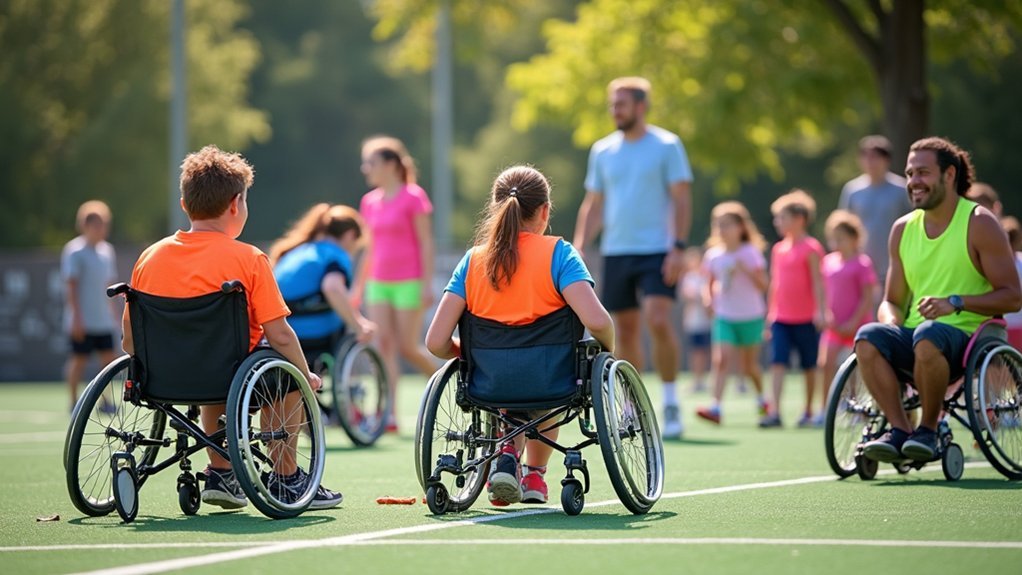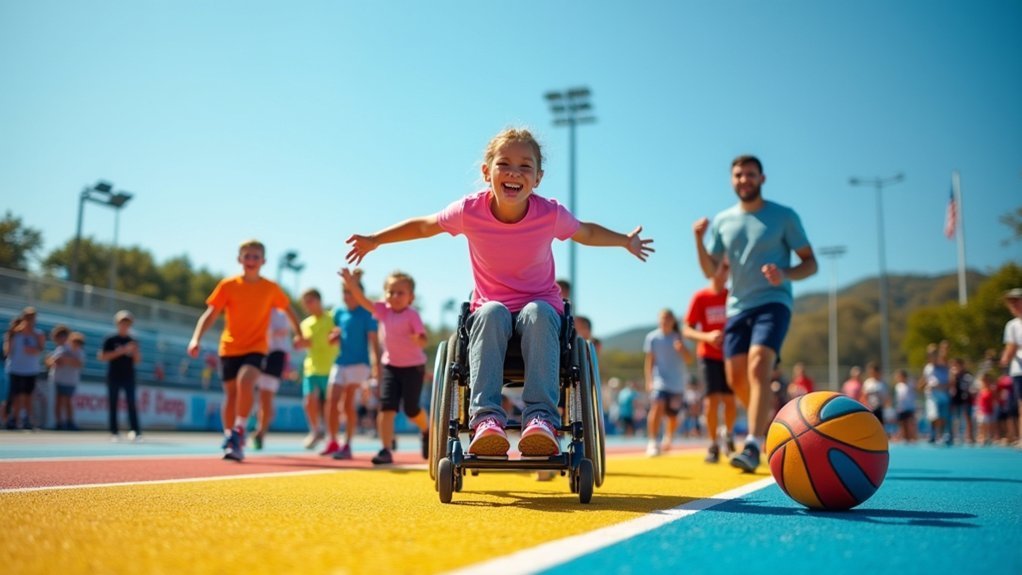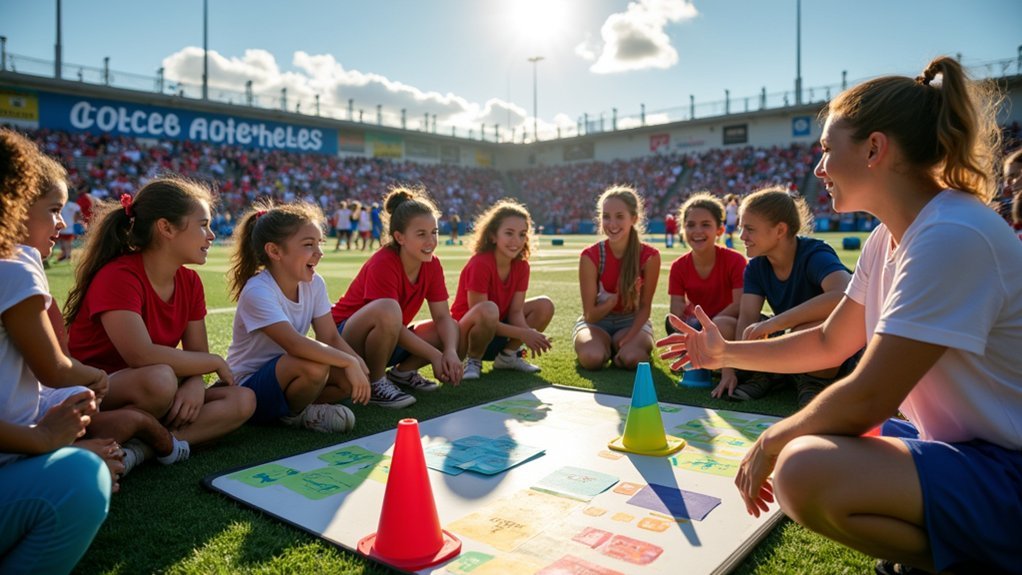Building inclusive sports programs requires creating sensory-friendly environments with reduced noise and clear visual supports. You’ll need to train coaches on diverse learning styles, develop adaptive equipment, and establish peer mentoring. Focus on family engagement, address transportation barriers, and cultivate community partnerships for sustainability. Don’t forget to measure success beyond traditional metrics—creating a space where all athletes feel valued matters most. The strategies ahead will transform how you welcome every participant.
Creating Sensory-Friendly Environments for All Participants

Five key elements transform standard sports facilities into sensory-friendly spaces where all athletes can thrive.
Start by reducing noise levels through sound-absorbing materials and establish soft lighting options to prevent sensory overload. Create designated quiet zones where neurodiverse participants can retreat when feeling overwhelmed.
Implement clear visual supports throughout your facility, including color-coded areas and simple signage to help athletes navigate confidently.
Confirm your coaching staff receives proper training on sensory processing differences and communication strategies for neurodiverse athletes.
Incorporate sensory-friendly activities like fidget tools and scheduled sensory breaks into your regular programming.
Finally, establish a feedback system where athletes and families can share their experiences, allowing you to continuously refine your sensory-friendly approach to better serve all participants.
Training Coaches to Support Diverse Learning Styles
While many sports programs focus primarily on physical skills and game strategy, effective coaches must also understand how athletes process and internalize information differently.
By implementing differentiated instruction techniques, you’ll enable coaches to connect with every athlete, regardless of their learning preferences.
Invest in professional development that emphasizes inclusive coaching practices. This approach not only recognizes athletes’ varying work ethic but also provides appropriate support systems that maximize potential.
Encourage coaches to utilize assessments to identify individual learning needs, then tailor their methods accordingly.
Consider partnering with educational psychology specialists who can provide coaches with practical tools for diverse learning styles.
This collaborative approach creates an environment where all athletes feel valued, improving team cohesion and ultimately enhancing performance outcomes.
Developing Adaptive Equipment and Modified Activities

Creating accessible sports programs requires thoughtful adaptation of equipment and activities to meet diverse physical needs. When you develop adaptive sports initiatives, focus on both specialized equipment and rule modifications to guarantee all athletes can participate meaningfully.
- Design or procure specialized equipment like adaptive wheelchairs, hand cycles, or seated throwing frames based on your participants’ specific requirements.
- Modify existing activities by adjusting rules, court dimensions, or scoring systems to accommodate different mobility levels.
- Partner with established adaptive sports organizations to leverage their expertise and resources when developing new programs.
- Establish regular feedback channels with your athletes who use adaptive equipment to continuously refine and improve designs.
Remember that successful adaptation isn’t just about the equipment itself—it’s about creating an environment where every athlete can experience the benefits of sports participation.
Building Peer Mentor Programs That Foster Connection
Because meaningful connections form the foundation of inclusive sports environments, peer mentor programs serve as powerful tools for building community among diverse athlete populations. When you pair experienced participants with newcomers, you create natural support systems that boost retention and emotional well-being for everyone involved.
| Mentor Program Benefits | For Mentors | For Mentees |
|---|---|---|
| Personal Growth | Leadership development | Increased confidence |
| Emotional Support | Sense of purpose | Reduced isolation |
| Program Sustainability | Enhanced commitment | Higher retention rates |
You’ll find structured mentorship meetings provide valuable opportunities for athletes to discuss challenges, celebrate wins, and build relationships across different sports. By implementing these peer mentor programs, you’re actively dismantling participation barriers while creating a unified team culture where all athletes feel genuinely valued.
Establishing Clear Communication Systems and Visual Supports

To build truly inclusive sports programs, effective communication systems and visual supports must form the backbone of your organizational structure.
When you standardize protocols for information sharing, you’ll guarantee everyone understands training expectations and schedules.
- Create visual charts and infographics that illustrate training objectives, making complex concepts accessible to all athletes.
- Implement mobile apps or digital platforms for real-time communication, allowing athletes to access information whenever they need it.
- Install posters and visual aids throughout facilities that demonstrate proper techniques and core movements.
- Schedule regular feedback sessions using visual performance data that empowers athletes to actively participate in their development.
These communication strategies foster an inclusive environment where athletes feel connected to the program and understand their roles within the team.
Designing Progressive Skill Development Pathways
When you establish clear development pathways for athletes of all abilities, you’ll release their full potential while fostering inclusive participation.
Design your progressive skill development pathways with multiple entry points to accommodate varying athletic abilities, guaranteeing everyone finds their place in your program.
Implement movement pattern-based training approaches that allow athletes to shift smoothly between sports while retaining and building upon existing skills.
Conduct regular assessments and performance testing to personalize training programs that adapt to each athlete’s unique progress.
Remember to incorporate holistic development strategies that address physical, mental, and emotional needs.
Encourage cross-sport interaction to promote skill sharing and community building.
This all-encompassing approach guarantees your athletes develop not just as competitors, but as well-rounded individuals capable of lifelong participation.
Measuring Success Beyond Traditional Athletic Metrics
While skill development establishes how athletes progress, a broader perspective on measuring success transforms how we evaluate our programs’ effectiveness. Your athletes need more than win-loss tallies to truly thrive in sports environments.
Consider these all-encompassing success indicators:
- Participation growth rates – Track engagement across diverse backgrounds and measure inclusivity rather than just competitive outcomes.
- Well-being metrics – Monitor mental and emotional health improvements to reduce dropout rates and foster positive culture.
- Community outreach impact – Measure the effectiveness of free camps and workshops in attracting underrepresented youth.
- Social development tracking – Assess teamwork, leadership skills, and peer interactions for holistic growth.
Implement regular athlete feedback systems to gauge their sense of belonging—this reveals whether you’re creating the welcoming environment all participants deserve.
Engaging Families as Essential Program Partners
Because family involvement directly impacts athlete success, your sports program can’t afford to treat parents and guardians as mere spectators. Research consistently shows that athletes with supportive families demonstrate higher motivation and performance levels.
Create regular communication channels that keep families informed and invite their participation. Schedule events where families can actively contribute, fostering a sense of community that increases both athlete retention and program satisfaction.
Don’t overlook the value of family feedback. Implement surveys and host meetings to gather insights that can help you tailor your program to better meet everyone’s needs.
When families feel heard and valued as partners, they become powerful advocates for your program, enhancing recruitment efforts and building a stronger foundation for long-term athlete development.
Addressing Transportation and Accessibility Barriers
Transportation challenges often present invisible barriers that keep talented athletes from ever stepping onto the field.
With 20% of interested youth citing transportation issues as their primary obstacle to participation, you’ll need strategic solutions to make your program truly inclusive.
Consider implementing these transportation strategies:
- Partner with local organizations to establish carpool systems that connect athletes within the same neighborhoods.
- Create a volunteer driver program with proper background checks and insurance coverage.
- Explore collaborations with public transit authorities for discounted passes or dedicated routes on practice days.
- Develop a transportation fund through sponsorships to subsidize rideshare services when other options aren’t available.
Cultivating Community Partnerships for Sustainable Growth
Successful sports programs rarely thrive in isolation; they’re built on the foundation of strong community partnerships. When you collaborate with local organizations and stakeholders, you’ll enhance your program’s visibility and create meaningful engagement opportunities.
Community partnerships help break down participation barriers by providing essential resources that make sports accessible to all youth athletes. You’ll find that these relationships often lead to increased funding and volunteer support, allowing you to invest in better facilities and training resources.
Don’t underestimate the value of establishing long-term connections with schools, businesses, and alumni. These relationships create a supportive network that reinforces sports’ role in community development.
Frequently Asked Questions
How Do You Structure an Athletic Program?
You’ll establish a unified athletic program with core values, consistent movement patterns, coordinated periodization plans, regular evaluations, and community-building activities. This structure guarantees all athletes develop efficiently regardless of their specific sport.
How to Build an Athlete Training Program?
You’ll need to establish core values, implement movement patterns across sports, use unified periodization, adjust volume for competitive seasons, and evaluate progress regularly. Don’t forget to maintain teamwork while accommodating sport-specific needs.
How to Grow an Athletic Program?
To grow your athletic program, you’ll need to engage with local communities, implement inclusive training for all skill levels, develop key partnerships, create unified strength programs, and build a strong team culture.
What Is the Biggest Issue in Sports Today?
The biggest issue in sports today is accessibility. You’re seeing many youth excluded due to financial barriers, declining interest post-pandemic, and social anxiety. These factors limit opportunities for kids to develop athletic skills and confidence.
In Summary
By embracing inclusive practices, you’re creating sports programs where every athlete can thrive. Don’t limit your vision of success to trophies alone—measure it by smiles, connections, and personal growth. When you remove barriers, train supportive coaches, and adapt activities thoughtfully, you’ll build a community where differences are celebrated. Remember, inclusive sports aren’t just “nice to have”—they’re essential to fulfilling the true promise of athletics for all.





Leave a Reply